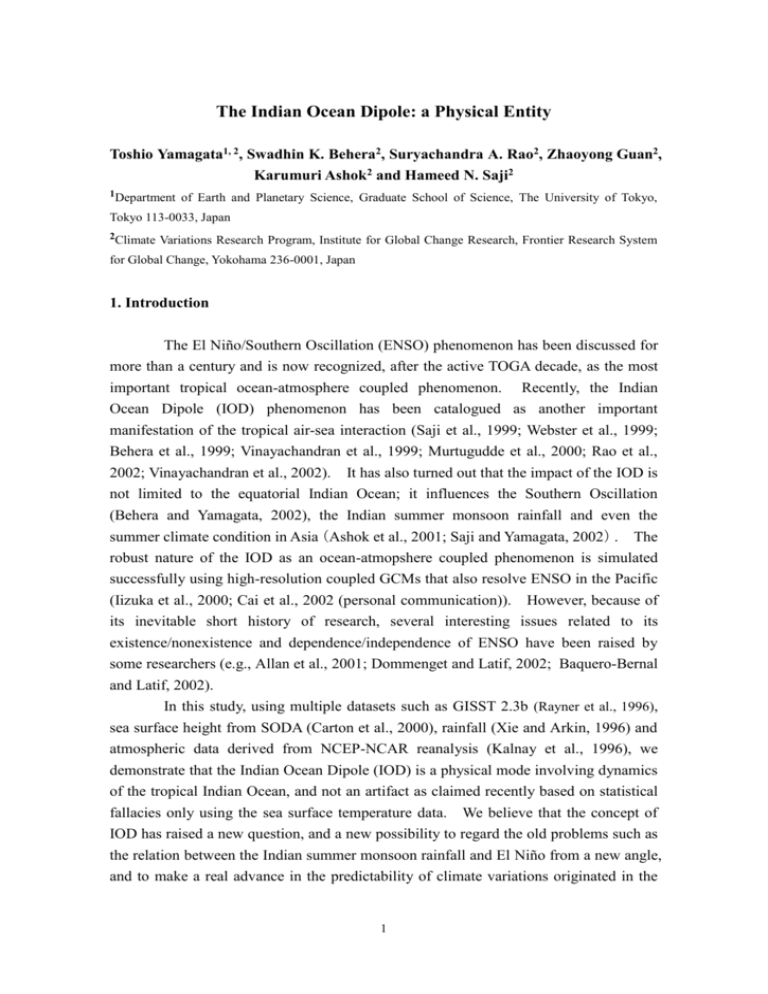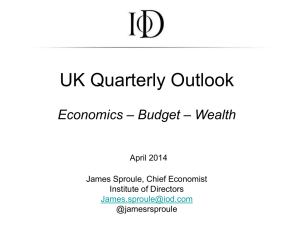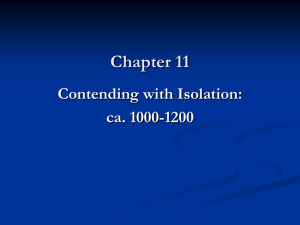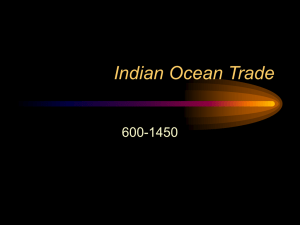The Indian Ocean Dipole and its Impact on the
advertisement

The Indian Ocean Dipole: a Physical Entity Toshio Yamagata1, 2, Swadhin K. Behera2, Suryachandra A. Rao2, Zhaoyong Guan2, Karumuri Ashok2 and Hameed N. Saji2 1Department of Earth and Planetary Science, Graduate School of Science, The University of Tokyo, Tokyo 113-0033, Japan 2Climate Variations Research Program, Institute for Global Change Research, Frontier Research System for Global Change, Yokohama 236-0001, Japan 1. Introduction The El Niño/Southern Oscillation (ENSO) phenomenon has been discussed for more than a century and is now recognized, after the active TOGA decade, as the most important tropical ocean-atmosphere coupled phenomenon. Recently, the Indian Ocean Dipole (IOD) phenomenon has been catalogued as another important manifestation of the tropical air-sea interaction (Saji et al., 1999; Webster et al., 1999; Behera et al., 1999; Vinayachandran et al., 1999; Murtugudde et al., 2000; Rao et al., 2002; Vinayachandran et al., 2002). It has also turned out that the impact of the IOD is not limited to the equatorial Indian Ocean; it influences the Southern Oscillation (Behera and Yamagata, 2002), the Indian summer monsoon rainfall and even the summer climate condition in Asia(Ashok et al., 2001; Saji and Yamagata, 2002). The robust nature of the IOD as an ocean-atmopshere coupled phenomenon is simulated successfully using high-resolution coupled GCMs that also resolve ENSO in the Pacific (Iizuka et al., 2000; Cai et al., 2002 (personal communication)). However, because of its inevitable short history of research, several interesting issues related to its existence/nonexistence and dependence/independence of ENSO have been raised by some researchers (e.g., Allan et al., 2001; Dommenget and Latif, 2002; Baquero-Bernal and Latif, 2002). In this study, using multiple datasets such as GISST 2.3b (Rayner et al., 1996), sea surface height from SODA (Carton et al., 2000), rainfall (Xie and Arkin, 1996) and atmospheric data derived from NCEP-NCAR reanalysis (Kalnay et al., 1996), we demonstrate that the Indian Ocean Dipole (IOD) is a physical mode involving dynamics of the tropical Indian Ocean, and not an artifact as claimed recently based on statistical fallacies only using the sea surface temperature data. We believe that the concept of IOD has raised a new question, and a new possibility to regard the old problems such as the relation between the Indian summer monsoon rainfall and El Niño from a new angle, and to make a real advance in the predictability of climate variations originated in the 1 tropics. 2. IOD as a physical entity As noted by previous studies using the EOF analysis, a basin-wide SST anomaly induced by the ENSO appears statistically as the most dominant interannual mode in the Indian Ocean (Cadet, 1985; Klien et al., 1999; Wallace et al., 1998; Venzke et al., 2000). The zonal dipole structure appears as the second mode. However, the dipole mode shows up as the dominant signal in some years. For example, it was the case during May through November in 1994. Behera et al. (1999) showed that a remarkable dipole in OLR anomalies also overlies the SST dipole (Fig. 1a). In contrast to the 1994 event where the dipole is prominent only in the Indian Ocean, a similar phenomenon in 1997 was accompanied by another dipole pattern in the Pacific due to simultaneous occurrence of the well-known El Niño event (Fig. 1b). The IOD phenomenon is not confined only to these two events. According to the GISST data, SST anomalies show opposite polarities in the eastern and western Indian Ocean during 178 months in total 504 months from 1958 to 1999. The opposite polarity in SST anomalies is associated with corresponding opposite anomalies in the zonal winds in central equatorial Indian Ocean. In response to the anomalous winds, the sea level was depressed (raised) in the eastern (western) Indian Ocean during the positive (negative) dipole events. The IOD indices derived from all these oceanic and atmospheric variables are shown in Fig. 2. All those indices are remarkably consistent with each other. Interestingly, one of the poles in the sea level anomalies capture the dipole mode very well as the dipole is the dominant mode of variability in the subsurface layer (Rao et al., 2002). This establishes the physical existence of the IOD beyond any doubt. In contrast to the above observation, Dommenget and Latif (2002) (hereafter referred to as DL) have questioned the existence of the IOD by only analyzing the SST data statistically despite the fact that the IOD is introduced as a physical mode based on various oceanic and atmospheric variables as discussed above. Since the fallacy of the DL’s argument is demonstrated in Behera et al (2002) (hereafter referred to as BRSY), we here discuss briefly the pitfall DL encountered and vindicate the physical existence of the IOD. DL believe that the existence of the dipole mode should necessarily lead to an anti-correlation between the two poles. As demonstrated in BRSY using a synthetic example, just like that in DL, the correlation reflects the dominant mode of variability (cf. Jolliffe 1987), which is the basin-wide monopole mode in the present case in a statistical sense. Therefore, an anticorrelation between the two poles can be 2 achieved only when the basin-wide mode is filtered out. BRSY have reconstructed the SST anomalies by removing the dominant EOF mode. Since dipole is now the dominant mode in the reduced data, a linear regression succeeds in reproducing the anti-correlation between the two poles (Fig. 3). Interestingly, the VARIMAX method also succeeds in identifying the dipole mode in contrast to DL because the basin-wide mode does not co-occupy the dipole mode. The spatial patterns thus obtained correspond very well with the composite maps shown in Saji et al (1999). The time series of the EOF and VARIMAX modes are also in excellent agreement with the DMI (Saji et. al. 1999) (Fig. 2). 3. IOD as a coupled mode inherent in the Indian Ocean Since we have demonstrated that the IOD really exists in the Indian Ocean, the next interesting question is whether IOD events in the Indian Ocean is independent of ENSO events in the Pacific. This is a natural question when we have two oscillators somehow related to each other under the global atmospheric bridge. Owing to the non-orthogonality between the two time series, the simultaneous correlation coefficient between DMI and Niño-3 indices is 0.37. The correlation coefficient increases in the seasonally stratified data, reaching up to 0.54 for September through November. Therefore, we are apt to conclude that IOD events occur as a part of ENSO events (Allan et al., 2001; Baquero-Bernal and Latif, 2002). However, the non-orthogonality of two time series does not necessarily mean that the two phenomena are always connected in a physical space. It is also important to note in general that the apparently high correlation of 0.54 explains only about 30% of total variance in terms of possible ENSO influence; we still have 70% variance unexplained by this external influence. To understand the physical nature of the possible connection, we investigate the Walker circulation that may connect the Indian Ocean with the Pacific through the atmospheric bridge. Here the Walker circulation is diagnosed from the zonal mass flux formulation as described by Newell et al.(1974) and Bergman and Hendon (2000). In order to distinguish the nature of the zonal cell in response to all IOD events and pure IOD events, we made two different composites. A positive (negative) IOD event is considered as a pure event when it is not accompanied simultaneously by El Niño (La Niña) (see Table I). The presence of the anomalous Walker cell in the Indian Ocean is clearly seen in both plots (Figs 4a and 4b). However, the composite for the pure IOD events (Fig. 4a) clearly shows an anomalous cell operating only in the Indian Ocean, thereby confirming the independent occurrence of the pure IOD. To escape from 3 misunderstanding, we repeat that this analysis does not exclude the possibility that some IODs may be physically linked with some ENSO events. The point of the matter is further clarified when we make similar composites for SST and sea surface height (Figs. 5 and 6). The SST composites (Fig. 5a and 5b) for all IOD events show dipole patterns in both the Indian Ocean and the Pacific Ocean. The warm anomaly pattern seen in eastern Pacific (Fig. 5a), however, disappears in the composite map of pure IOD events (Fig. 5b). Those are consistent with the composites of the Walker circulation shown in Fig. 4. In contrast, the pure ENSO composite (see Table I) does not show any basin-wide dipole pattern in the Indian Ocean, as expected. Cold SST anomalies are, however, seen along the coast of Australia and near the Indonesian throughflow region in the pure ENSO composite (Fig. 5d). Fig. 6d shows negative sea surface height anomalies associated with this coastal phenomenon without the basin-wide scale. This phenomenon is due to intrusion of the western Pacific signal during the mature phase of El Niño through the Indonesian passage and the subsequent spreading of water mass along the Australian coast by coastal Kelvin waves. It is discussed by Clarke and Liu (1994) theoretically and confirmed by Meyers (1996) using XBT data; we prefer to call this as the Clarke-Meyers effect. Although the above coastal phenomenon explains partly the high correlation between DMI and Niño-3 particularly during the boreal fall, it should not be confused with the basin-wide phenomenon of IOD (Fig. 5d). Both the pure and all IOD composites show clearly that the lower sea surface height anomaly in the eastern Indian Ocean is accompanied by the higher anomaly in the central Indian Ocean (Fig 6a and 6b). However, such a pattern is completely missing in the pure ENSO composites. The fact that sea surface height do not show any significant east-west slope in case of the pure ENSO suggests that basin-wide ocean dynamics do not play a major role in the development of SST anomalies associated with the pure ENSO; this has been demonstrated by Rao et al. (2002). 4. IOD influence on the surrounding climate Since the indices of ENSO and the IOD are non-orthogonal, it is reasonable to raise a counter issue that the Pacific ENSO itself may be affected by the IOD. Using partial correlation analysis, Behera and Yamagata (2002) are successful in revealing such an inverse influence on the Southern Oscillation Index. It is found that the DMI has a peak correlation coefficient of 0.4 with the Darwin pressure index when the former leads the latter by one month. When the Darwin index leads by 3 months, the 4 correlation coefficient (0.2) drops below the significant level. The pressure index of the central-west Pacific region shows a peak correlation of about 0.3 when DMI leads the central-west Pacific index by 4-5 months. This suggests that some IOD events precede some ENSO events. In Fig. 2, we find that three of the major warm ENSO events (i.e., those in 1972, 1982, 1997) are associated with positive IOD events. In contrast, three of the major positive IOD events (i.e., those in 1961, 1967 and 1994) were not accompanied by the warm ENSO events. This again suggests the likelihood of the Pacific phenomenon being influenced by the phenomenon originated in the Indian Ocean. The above relationship undergoes decadal modulation with a good correlation during three sub-periods of 1958-67, 1968-76 and 1988-97. The correlation, however, is significantly reduced during the decade of 1977 through 1987. Less frequent occurrence of IOD in the decade explain the reduction in the correlation. Similar decadal modulation of the IOD impact on the Indian summer monsoon rainfall has been recently discussed by Ashok et al., (2001). The influence of the IOD is not just confined to the tropical region, but reaching far to the whole globe (Saji and Yamagata, 2002). Owing to the non-orthogonality of the IOD and ENSO indices, however, the vast IOD influences have not been appreciated so far. In a series of articles, Saji and Yamagata (2002), using a partial correlation analysis, have demonstrated that the enhancement of the East African rain is dominated by the positive IOD rather than El Niño. Interestingly, the positive IOD and the warm episode of ENSO have opposite influences in the Far East including in Japan and Korea; positive (negative) IOD events give rise to warm and dry (cold and wet) summer owing to enhancement of downdraft in the troposphere. This was clearly recorded during the IOD events in 1961, 67, 1994, as compared to the simultaneous occurrence of the positive IOD and the El Niño during 1997. The Indian summer monsoon rainfall (ISMR) is enhanced (decreased) during positive (negative) IOD events; the recent weakening of ENSO-ISMR relation may be interpreted in terms of frequent occurrence of the positive IOD in the recent decade (Ashok et al., 2001). In the Southern Hemisphere, the IOD impact is remarkable in the southwestern Australia and Brazil because of propagation of planetary waves in the winter hemisphere; positive (negative) IOD events cause warm and dry (cold and wet) conditions. The mechanism for these global teleconnection certainly needs further investigation. We get busy. 5. Summary and discussion 5 The brief report presented here from our recent work has shown various interesting aspects of the climate variation in the Indian Ocean simply because we obtain a novel viewpoint so far neglected. The IOD appears as the second dominant mode in the EOF analysis of SST anomalies, as compared to the gravest basin-wide mode related to ENSO events. We should note that the statistical dominance does not necessarily mean physical dominance (e.g. Figs.1 and 2). This is because less frequent occurrence explains the lower position in statistics. Actually, the IOD signal in the Indian Ocean is clearly seen even in the raw SST data in 1961, 1967, 1972, 1982, 1994, 1997 (e.g. Meyers 1996; Saji et al 1999, Behera et al. 1999). This also confirms the physical existence of the IOD in the simplest way despite that recent statistical analyses by several authors (Baquero-Bernal and Latif, 2002; Allan et al., 2001) have claimed that the IOD is a statistical artifact. We have shown results from the composite analysis of the Walker circulation, SST and sea surface height anomalies in order to check whether IOD events in the Indian Ocean are just slaves to the Pacific ENSO events. It is found that an independent Walker cell may operate within the Indian Ocean during pure IOD events. The intrinsic property is further reflected in the SST composites. During pure IOD events, the composite plot does not show any significant SST anomalies in the Pacific. Interestingly, the composite pictures of SST and sea surface height revealed that, during mature stage of pure ENSO events, those anomalous fields are only evident near the western coast of Australia. The mature ENSO signal passes through the Indonesian throughflow and spreads along the Australian coast through the oceanic process of the Clarke-Meyers effect. This explains the high correlation between DMI and the Nino-3 during September-November. However, these anomalies are different from the signal associated with the basin-wide IOD wherein the remarkable dipole structure in SST and sea surface height anomalies are seen in the eastern and western Indian Ocean with a basin-wide scale (Figs 5 and 6). The above is consistent with a recent observational analysis of fossil corals off Sumatra (Mentawai Island) that traces an independent IOD signal back to the mid-Holocene (6000-yr) period (Abram et al. 2001). As discussed, IOD may evolve without the external forcing from the Pacific ENSO but it interacts with the Pacific phenomenon in some occasions possibly through the atmospheric bridge (Behera and Yamagata, 2002) and partly via the oceanic throughflow around the Australian continent. The strong seasonal phase-locking of the interannual IOD events may be related to the latter. However, it is crucially important to appreciate first the real unique nature of the Indian Ocean Dipole as the air-sea coupled phenomenon unique to the tropical Indian Ocean and then to clarify ways of 6 interaction with other important phenomenon such as the ENSO events. We believe that this approach is a healthy way in understanding physics. We have not discussed here much about the subsurface IOD signals and successful coupled model simulations. Those who are interested are referred to Rao et al. (2002) and Iizuka et al. (2001). We hope that the present brief report on the Indian Ocean Dipole stimulates the world climate research community from a new angle of shedding light on old problems in the Asia-Pacific region. 7 Table. 1 Years of positive and negative IOD yearss, and El Niño and La Niña years based on DMI and Niño-3 indices. Pure events are shown in bold i.e. no El Niño during positive IOD and no La Niña during negative IOD events considering a possible atmospheric bridge that can give rise to such interferences. No. Years of Years of Years of Years of Positive IOD Negative IOD El Niño La Niña 1 1961 1958 1963 1964 2 1963 1960 1965 1967 3 1967 1964 1969 1970 4 1972 1970 1972 1971 5 1977 1989 1976 1973 6 1982 1992 1982 1975 7 1994 1996 1986 1988 8 1997 Years in bold are when pure IOD 1991 1999 evolved i.e. no El Niño during positive IOD and no La Niña during negative IOD events. 1997 9 8 References: Abram, N. J., M. K. Gagan, W. S. Hantoro, M. T. McCulloch, and J. Chappell, 2001: Coral records of the Indian Ocean Dipole, American Geophysical Union, Fall Meeting, San Francisco, Calif., Dec. 2001. Allan, R., D. Chambers, W. Drosdowsky, H. Hendon, M. Latif, N. Nicholls, I. Smith, R. Stone,Y. Tourre, 2001: Is there an Indian Ocean dipole, and is it independent of the El Niño - Southern Oscillation? CLIVAR Exchanges, 6, 18-22. Ashok, K., Z. Guan, and T. Yamagata, 2001: Impact of the Indian Ocean Dipole on the Decadal relationship between the Indian monsoon rainfall and ENSO, Geophys. Res. Lett., 28, 4499-4502. Baquero-Bernal, A., and M. Latif, 2002: On dipole-like variability in the tropical Indian Ocean. J. Climate, (in press). Behera, S. K., R. Krishnan, and T. Yamagata, 1999: Unusual ocean-atmosphere conditions in the tropical Indian Ocean during 1994. Geophys. Res. Lett., 26, 3001-3004. Bergman, J. W., and H. H. Hendon, 2000: Cloud radiative forcing of the low latitude tropospheric circulation: linear calculations. J. Atmos. Sci., 57, 2225-2245. Cadet, D. L., 1985: The Southern Oscillation over the Indian Ocean. J. Climatol., 5, 189-212. Carton, J.A., G. Chepurin, X. Cao, and B.S. Giese, 2000: A Simple Ocean Data Assimilation analysis of the global upper ocean 1950-1995, Part 1: methodology, J. Phys. Oceanogr., 30, 294-309. Clarke, A. J., and X. Liu, 1994: Interannual sea level in the Northern and Eastern Indian Ocean. J. Phys. Oceanogr., 24, 1224–1235. Dommenget, D. and M. Latif, 2002: A cautionary note on the interpretation of EOFs. J. Climate, 15, 216-225. Iizuka, S., T. Matsuura, and T. Yamagata, 2000: The Indian Ocean SST dipole simulated in a coupled general circulation model. 3369-3372. Geophys. Res. Lett., 27, Jolliffe, I. T., 1987: Rotation of principal components: some comments. J. Climotol. 7, 507-510. Kalnay, E. and Coauthors, 1996: The NCEP/NCAR 40-year reanalysis project. Bull. Amer. Meteor. Soc., 77, 437-471. Klein, S. A., B. J. Soden, and N. C. Lau, 1999: Remote sea surface temperature variations during ENSO: Evidence for a tropical atmospheric bridge. J. Climate, 12, 917-932 9 Meyers, G., 1996: Variation of Indonesian throughflow and El Niño - Southern Oscillation, J. Geophys. Res., 101, 12,255-12,263. Murtugudde, R. G., J. P. McCreary, and A. J. Busalacchi, 2000: Oceanic processes associated with anomalous events in the Indian Ocean with relevance to 1997-1998. J. Geopys. Res., 105, 3295-3306. Newell, R. E., J. W. Kidson, D.G. Vincent and G. J. Boer, 1974, The General Circulation of the Tropical Atmosphere. Vol. 2, The MIT Press, 371 pp. Rao, A. S., S. K. Behera, Y, Masumoto, and T. Yamagata, 2001: Interannual variability in the subsurface tropical Indian Ocean. Deep- Sea Res. II, 49, 1549-1572. Rayner, N.A., E.B. Horton, D.E. Parker, C.K. Folland, and R.B. Hackett, 1996, Clim. Res. Tech. Note 74, UK Meteorological office, Bracknell. Saji, N. H., B. N. Goswami, P. N. Vinayachandran, and T. Yamagata, 1999: A dipole mode in the tropical Indian Ocean. Nature, 401, 360-363. Saji, N. H., and T. Yamagata, 2002: Interference of teleconnection patterns generated from the tropical Indian and Pacific Oceans (under preparation). Venzke, S., M. Latif, and A. Villwock, 2000: The coupled GCM ECHO-2. Part II: Indian Ocean Response to ENSO. J. Climate, 13, 1371-1387. Vinayachandran, P.N., Krishna, ?, and T. Yamagata, 1999: ???, Geophys. Res. Lett. Vinayachandran, P. N., S. Iizuka, and T. Yamagata, 2002: Indian Ocean Dipole mode events in an ocean general circulation model, Deep- Sea Res., (In Press). Wallace, J. M., E. M. Rasmusson, T. P. Mitchell, V.E. Kousky, E. S. Sarachik, and H. von Storch, 1998: On the structure and evolution of ENSO-related climate variability in the tropical Pacific. J. Geophys. Res., 103, 14241-14260 Webster, P. J., A. M. Moore, J. P. Loschnigg, and R. R. Leben, 1999: The great Indian Ocean warming of 1997-98: Evidence of coupled-atmospheric instabilities. Nature, 401, 356-360 10 Figure Caption: Fig. 1: Anomalies of OLR for September-November. a) 1994, b) 1997. Fig. 2: Normalized indices of IOD, based on the anomalies of SST (SSTDMI) , zonal wind (UDMI), sea level (SSHDMI) and sea level pressure (SLPDMI). SSTDMI is obtained by taking anomaly difference between two regions (500E-700E, 100S-100N) and (900E-1200E, 100S-Eq), whereas SLPDMI is obtained by taking the difference between two boxes (860E-870E, 100S-90S) and (440E-450E, 150S-140S). The UDMI is obtained by taking area-average in the central equatorial region (700E-900E, 50S-50N). The SSHDMI is obtained by taking area -average of the TOPEX/POSEIODN sea level anomalies in a region in the eastern Indian Ocean (900E-1100E, 100S-Eq). The SSTDMI has a correlation coefficient above 0.65 with other indices. Niño-3 index from the eastern Pacific is shown for reference. Fig.3: Correlation between eastern pole and the whole basin anomalies after removal of anomalies due to the first EOF mode. Fig.4: September through November IOD composite ((positive events-negative events)/2) of zonal mass flux for (a) all IOD events (b) pure IOD events. Contour interval is 4*109 kg s-1. Fig. 5: Composite of SST anomalies during September through November for (a) all IOD events (b) pure IOD events, (c) all ENSO events and (d) pure ENSO events. Values are in 0C. Fig. 6: Same as in Fig. 4 but for the composite of SSH. Values are in cm. 11








